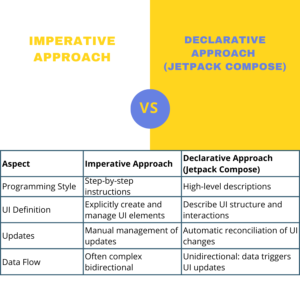
Table of Contents
What is Flow?
- Imagine a Flow as a continuous stream of data. It’s like a river that flows, and you can dip a cup into it to get some water (data).
- In programming, Flow represents a sequence of values that can be asynchronously computed and delivered over time.
- It’s a way to handle data that arrives at different intervals, such as fetching data from a database or streaming updates.
What is StateFlow?
- Think of StateFlow as a specific type of Flow. It’s like a stream of water (data) with a current state.
- In programming, StateFlow represents a value that can be observed over time, and whenever the value changes, you can react to it.
- It’s often used to represent the state of a user interface or application, such as whether a button is pressed or a user is logged in.
What is SharedFlow?
- SharedFlow is another type of Flow but with a difference. It’s like a shared water source that multiple people can access and get water (data) from.
- In programming, SharedFlow allows multiple observers (listeners) to listen to the same stream of data independently.
- It’s useful when you want multiple parts of your application to react to the same data source without interfering with each other.
Differences:
- Flow vs. StateFlow:
- Flow is a general concept representing a sequence of values over time.
- StateFlow is a specific type of Flow that represents a value with a current state.
- Flow is typically used for asynchronous data operations.
- StateFlow is often used to represent the state of an application or UI element that needs to be observed and reacted to.
- Flow vs. SharedFlow:
- Flow represents a single stream of data that can be consumed by one observer.
- SharedFlow allows multiple observers to independently consume the same stream of data.
- Flow is suitable when you have a single consumer of data.
- SharedFlow is useful when you want multiple parts of your application to react to the same data source.
- StateFlow vs. SharedFlow:
- StateFlow is a specific type of Flow with a current state that represents the state of an application or UI element.
- SharedFlow is a more general type of Flow that allows multiple observers to access the same data stream independently.
- StateFlow is often used for representing the state of UI elements.
- SharedFlow is used when you need to share data among multiple parts of your application.
Flow
Flow is a cold asynchronous stream of data that emits values over time. It is suitable for handling sequences of data, such as fetching data from a network source.
import kotlinx.coroutines.flow.Flow
import kotlinx.coroutines.flow.flow
import kotlinx.coroutines.flow.collect
// Define a function that returns a Flow
fun getData(): Flow<Int> = flow {
for (i in 1..5) {
// Emit values from 1 to 5
emit(i)
// Simulate a delay between emissions
kotlinx.coroutines.delay(1000)
}
}
// Usage of the Flow
fun main() {
// Collect and print values from the Flow
getData().collect { value ->
println("Received: $value")
}
}
Explanation:
- We import the necessary libraries for working with
Flow. - We define a function
getData()that returns aFlow<Int>. Inside theflowbuilder, we emit integers from 1 to 5 with a delay of 1 second between emissions. - In the
main()function, we collect and print the values emitted by theFlowusing thecollectfunction. This is a suspending function that waits for emissions.
SharedFlow
SharedFlow is similar to Flow, but it allows multiple collectors to share the same stream of data.
import kotlinx.coroutines.flow.MutableSharedFlow
import kotlinx.coroutines.flow.collect
// Create a MutableSharedFlow
val sharedFlow = MutableSharedFlow<Int>()
// Add collectors
fun main() {
// First collector
sharedFlow.collect { value ->
println("Collector 1 received: $value")
}
// Second collector
sharedFlow.collect { value ->
println("Collector 2 received: $value")
}
// Emit values to the SharedFlow
sharedFlow.tryEmit(1)
sharedFlow.tryEmit(2)
}
Explanation:
- We import the necessary libraries for working with
MutableSharedFlow. - We create a
MutableSharedFlowcalledsharedFlow, which allows multiple collectors to receive values. - In the
main()function, we add two collectors tosharedFlow, and both will print the values they receive. - We use the
tryEmitfunction to emit values (1and2) to thesharedFlow, and both collectors receive these values.


StateFlow
StateFlow is a special type of SharedFlow designed for representing a single, most recent state. It’s commonly used for UI-related state management.
import kotlinx.coroutines.flow.MutableStateFlow
import kotlinx.coroutines.flow.collect
// Create a MutableStateFlow with an initial state
val stateFlow = MutableStateFlow(0)
// Add a collector
fun main() {
// Collector
stateFlow.collect { value ->
println("StateFlow received: $value")
}
// Update the state
stateFlow.value = 1
stateFlow.value = 2
}
FAQs
Q1: Can I use Flow and StateFlow together in the same project?
Yes, you can use both Flow and StateFlow in the same Android project. They serve different purposes and can complement each other in various scenarios.
Q2: Are Flow and Shared Flow compatible with older Android versions?
Yes, Flow, Shared Flow, and StateFlow are compatible with older Android versions, thanks to Kotlin’s backward compatibility.
Q3: How do I handle errors with StateFlow?
You can handle errors in StateFlow by emitting a specific error state when an error occurs and then observing and reacting to that state in your UI.
Q4: Can I use Flow in Java-based Android projects?
Flow is primarily designed for Kotlin-based Android projects. While it’s technically possible to use Flow in Java, it’s more seamless and effective in Kotlin.

Feel free to follow and join my email list at no cost. Don’t miss out — sign up now!
Please check out my earlier blog post for more insights. Happy reading!
The Innovative Fundamentals of Android App Development in 2023
How to learn Android App Development in 2023 – Full Guide For Beginners using Kotlin Language
Ultimate Guideline on How to Use ViewModel Design Pattern
What is the Repository Pattern in Android? A Comprehensive Guide
What is ViewModel in Android? A Good Guide for Beginners
The Innovative Fundamentals of Android App Development in 2023
How to Say Goodbye to Activity Lifecycle and Say Hello to Compose Lifecycle ?
How to Monitor/Observe Network Availability for Android Projects
Exploring Sealed Class vs Enum in Kotlin Which is Best for Your Code?
What is the difference between Functional Programming and OOP?



